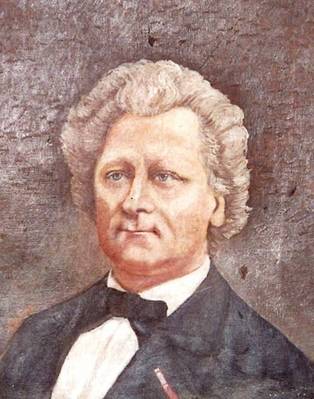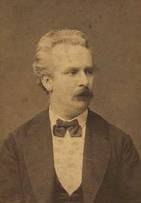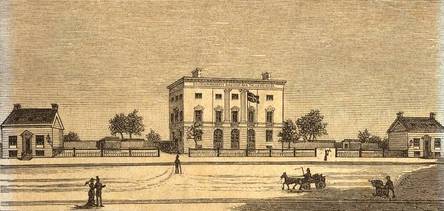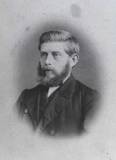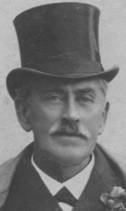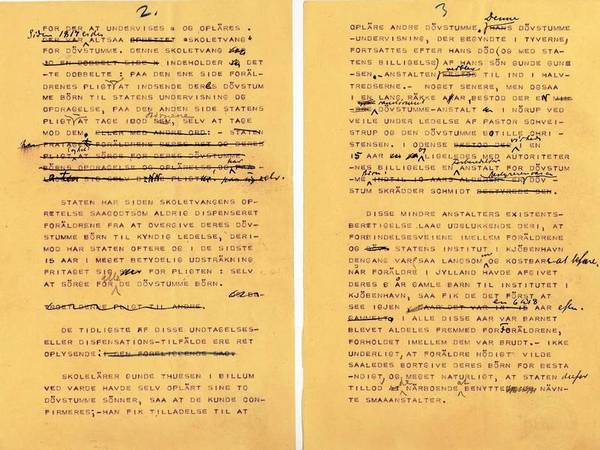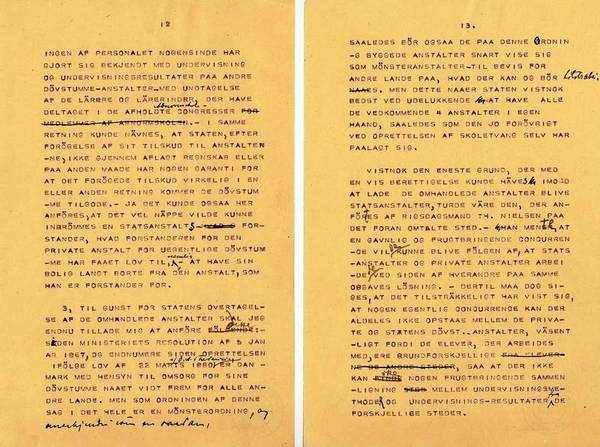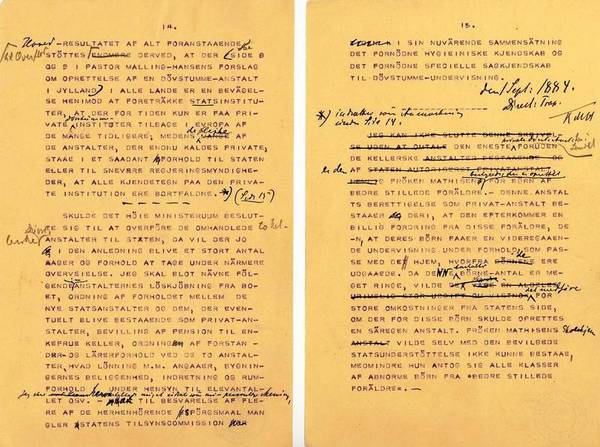1884.09.01 English
SA: In relation to the teaching of deaf-mute pupils, for a number of years there were in Denmark two different “power centers”, one represented by professor Johan Keller, developing and expanding his private schools for what he called the “imbecile” and for deaf-mute children – the so-called Keller Institutions; the other center represented by Rasmus Malling-Hansen, principal of the governmentally run Institute for the Deaf-Mute in Copenhagen. Keller started his career of education for deaf-mute children in 1858, when he took over a school for the deaf-mute established as an experimental scheme for teaching according to the “new” pedagogical method, the so-called lip-reading method, from a previous teacher of the Institute for the Deaf-Mute in Copenhagen, reverent Dahlerup. Malling-Hansen took over as principal of the Institute for the Deaf-Mute in Copenhagen in 1865.
During certain periods Keller and Malling-Hansen cooperated very closely, and among other things they co-published the journal “Smaablade for Døvstumme” (‘Leaflets for the Deaf-Mute’) throughout the year 1872. This journal contains some excellent religious texts, but unfortunately such texts were not signed, and hence it is not possible to decide which of the two gentlemen who wrote what. However, there were also conflicts between them, and what began as professional and institutional disagreements developed into serious personal clashes. In order to arrive at some kind of arrangement regarding the distribution of pupils between the two kinds of institutes, acceptable to both, they agreed in 1867 on a distribution scheme whereby those pupils that had been born completely deaf were to be taught at the Royal Institute for the Deaf-Mute in accordance with the “old” sign method, while pupils with some degree of hearing were to be taught at the Keller Institutes following the speech method, while the ‘imbecile’ deaf-mute were to be taught according to the sign method at those same institutions. This division represented not only a practical arrangement between the two institutions but was also a very early attempt to provide education adapted to the pupils’ individual pre-conditions and talents, and this arrangement was known as “The Danish Division”.
However, in the long run Malling-Hansen was unhappy with this arrangement, because he felt that Keller tended to enrol pupils who really belonged at the Institute for the Deaf-Mute. Keller was dependent upon government subsidies and hence had vested interests in enrolling as many pupils as possible, since this was linked to increased subsidies. This point was a cause for permanent conflict between the two schools throughout the 1870s and 1880s. During this period Malling-Hansen demonstrated a very progressive ability to think in overall terms and along unbeaten tracks – not only short-sightedly in the interests of his “own” institute. The enrolment numbers were steadily rising, a new school was needed, and in 1879 Malling-Hansen presented a proposal to establish a new governmental institution, where teaching was to be exclusively in accordance with the speech method, and this proposal led to the establishment of the Institute for the Deaf-Mute in Fredericia, finalised in 1881.
However, this did not stop the conflict between Keller and Malling-Hansen, clearly evident in a letter Keller wrote to his superiors in 1881 in which he regretted in strong terms that his private institutions were very poorly represented in the selection committee that decided about the most suitable placement of the deaf-mute pupils. He feared that his institutions would suffer and begged for his institutions that they be awarded a fix government subsidy instead of a subsidy as per each enrolment, since he was worried that the economic basis for his schools would otherwise become too weak. At this point in time it appears that RMH had managed to put Keller “in a pinch” by having the government institutions vastly overrepresented in the selection committee. Malling-Hansen was a constant and zealous supporter of organising the teaching of the deaf-mute in accordance with an overall government plan, and it appears from the letter below – addressed by Malling-Hansen to his superiors in 1884 just after the surprising demise of Johan Keller – that RMH was of the opinion that the government should completely take over the running of the Keller institutions as regards those parts teaching deaf-mute children. Otherwise, the demise of Keller in one stroke rid Malling-Hansen of a great fear that he had been harbouring for some time, namely that Keller might be appointed Director of the Royal Institute for the Deaf-Mute, following the previous director, J.P.Trap’s serious illness and resignation. However, instead of having RMH’s biggest “competitor” appointed, the government appointed the former minister for Schleswig, counsellor Wolfhagen, and very soon RMH found himself in big conflicts with him instead, since he was a man with very strong views about how to run the institute, often contrary to what RMH wanted.
The letter below, obviously written after a request for RMH’s opinion whether Johan Keller’s widow, son and brother were to be allowed to continue running those parts of the Keller institutions that taught deaf-mute children, did not have the desired effect, seen from RMH’s point of view. The Keller Institutions, granted a government loan as late as 1880 in order to construct new and better classrooms, were not taken over by the government. On the other hand it was decided to set up a commission at a later stage with the task of analysing and presenting a bill for the entire organisation of education for the deaf-mute in Denmark. The commission was set up in 1888, and RMH together with the principal of the Fredericia Institute, Georg Jørgensen, in practise were the authors behind the commission proposal. Not surprisingly the commission proposed – in addition to many other things – that the Keller Institutions should be taken over by the government – a proposed law also passed by parliament in 1890 – and consequently RMH’s ideas were to emerge “victorious” in the conflict with Johan Keller.
Proposal to the Ministry September the First 1884 Concerning the Institutions left by Professor Keller[1] [2]
IN LETTER OF JUNE 12 THIS YEAR THE MINISTRY HAS REQUESTED MY COMMENTS REGARDING THE ATTACHED APPLICATION, IN WHICH THE WIDOW AFTER THE LATE PROFESSOR KELLER, MRS CATHRINE KELLER, COMMUNICATES THAT SHE, IN HARMONY WITH THE WISHES OF HER LATE HUSBAND, INTENDS TO CONTINUE THE VOCATION OF HER HUSBAND, PENDING MINSTERIAL AGREEMENT, AND REQUESTS MINISTERIAL APPROVAL FOR THE INSTITUTIONS ESTABLISHED AND DIRECTED BY PROFESSOR TO BE RUN IN FUTURE ON BEHALF OF HER HUSBAND’S BROTHER, PRINCIPAL EMIL KELLER, LLB, AND BY HER SON, MR CHR.KELLER[3]
ON THIS ACCOUNT, I ALLOW MYSELF TO SUBMIT THE FOLLOWING:
THE ATTACHED APPLICATION IN ESSENCE AIMS AT ACQUIRING PERMISSION TO LET THE LATE PROFESSOR KELLER’S INSTITUTIONS CONTINUE TO FUNCTION AS PRIVATE INSTITUTIONS. CONTRIBUTING TO THE ASSESSMENT WHETHER SUCH A PERMISSION MAY BE GRANTED, ALLOW ME TO INITIALLY PRESENT SOME INFORMATION REGARDING THE TEACHING OF DEAF-MUTE IN THIS COUNTRY.
ACCORDING TO THE CHARTER OF APRIL 17, 1807 OF THE ROYAL INSTITUTE FOR THE DEAF-MUTE AND EVEN MORE CLEARLY THE MINISTERIAL ORDER OF APRIL 11, 1817, ALL DEAF-MUTE CHILDREN WERE TO BE ENROLLED AT THE ROYAL INSTITUTE FOR THE DEAF-MUTE IN COPENHAGEN IN ORDER TO BE TAUGHT AND BROUGHT UP THERE.
IN OTHER WORDS, EVER SINCE 1817 SCHOOLING FOR DEAF-MUTE CHILDREN HAS BEEN OBLIGATORY. COMPULSORY SCHOOL ATTENDANCE CONTAINS IN ITSELF THIS DOUBLE EDGE[4]: ON THE ONE HAND THE DUTY OF THE PARENTS TO SEND THEIR DEAF-MUTE CHILDREN TO BE EDUCATED UNDER GOVERNMENT MANAGEMENT, AND ON THE OTHER HAND THE DUTY OF THE GOVERNMENT TO ACCEPT THE CHILDREN AND CATER FOR THEIR EDUCATION.
EVER SINCE THE INTRODUCTION OF COMPULSORY EDUCATION [5] THE GOVERNMENT HAS ALMOST NEVER EXEMPTED PARENTS FROM SURRENDERING THEIR DEAF-MUTE CHILDREN TO EXPERT EDUCATIONALISTS, HOWEVER THE GOVERNMENT HAS MORE OFTEN – AND DURING THE LAST 15 YEARS TO QUITE A LARGE EXTENT – EXEMPTED ITSELF FROM ITS DUTY: TO CATER FOR THE EDUCATION OF ALL DEAF-MUTE CHILDREN.
THE VERY FIRST OF THESE CASES OF EXEMPTION ARE QUITE ILLUSTRATIVE:
TEACHER GUNDE THUSESEN, BILLUM BY VARDE, HAD ON HIS OWN TAUGHT HIS TWO DEAF-MUTE SONS UNTIL THEIR CONFIRMATION; HE WAS GRANTED PERMISSION TO TEACH OTHER DEAF-MUTE CHILDREN. THIS EDUCATION, BEGUN IN THE 1820’S, WAS CARRIED ON AFTER HIS DEATH (AND WITH THE AUTHORITY OF THE GOVERNMENT) BY HIS SON GUNDE THUESEN. THE INSTITUTION FUNCTIONED UNTIL SOMETIMES IN THE 1850’S. SOMEWHAT LATER, AND ALSO IN THIS CASE FOR AN EXTENDED PERIOD, THERE WAS A SMALL INSTITUTE FOR THE DEAF-MUTE AT NÖRUP BY VEJLE HEADED BY REVERENT SVEISTRUP. LIKEWISE, IN ODENSE, FOR A PERIOD OF 15 YEARS AND WITH OFFICAL APPROBATION, THERE WAS AN EDUCATIONAL INSTITUTION FOR DEAF-MUTE CHILDREN. THE PRINCIPAL WAS A TAYLOR, A DEAF-MUTE BY THE NAME OF SCHMIDT.
THE JUSTIFICATION FOR THE EXISTENCE OF THESE VERY SMALL INSTITUTIONS RESTED ENTIRELY WITH THE FACT THATTRANSPORT AND COMMUNICATION BETWEEN THE PARENTS AND THE ROYAL INSTITUTE IN COPENHAGEN AT THE TIME WAS VERY SLOW AND COSTLY. ONCE CHILDREN IN JUTLAND HAD SURRENDERED THEIR 8 YEAR OLD CHILD TO THE INSTITUTE IN COPENHAGEN, THEY WOULD ONLY SEE IT AGAIN SOME 6 TO 8 YEARS AFTERWARDS. IN THE COURSE OF THIS LONG PERIOD THE CHILD HAD BECOME QUITE ALIENATED TO THE PARENTS, AND THE NATURAL RELATIONSHIP WOULD BE BROKEN. – CONSEQUENTLY, IT IS NO WONDER THAT PARENTS ONLY VERY RELUCTANTLY WOULD WISH TO SURRENDER THEIR CHILDREN FOR EVER, AND IT WAS ALSO VERY UNDERSTANDABLE THAT THE STATE THEREFORE ACCEPTED THAT PARENTS IN SUCH CIRCUMSTANCES TOOK ADVANTAGE OF SUCH SMALLISH, LOCAL SCHOOLS.
IN CONTRAST TO THIS SITUATION, THE PUPILS OF THE ROYAL INSTITUTE FOR THE DEAF-MUTE HAS, SINCE EIGHTEEN YEARS, BEEN ABLE TO SEND ITS PUPILS HOME TO THEIR PARENTS FOR FIVE WEEKS EACH YEAR. NO LONGER ARE THE CHILDREN AND THEIR PARENTS ALIENATED TO EACH OTHER, AND HENCE THE’ RAISON D’ETRE’ OF THESE SMALL INSTITUTIONS DISPAPPEARED, AND THIS IS WHY THE LAST OF THEM CLOSED DOWN ALREADY 16 YEARS AGO.
IN OTHER WORDS, ONLY WHEN THERE WAS A SPECIFIC REASON AT HAND, THESE INSTITUTIONS WERE ALLOWED TO FILL IN THE DUTIES OF THE STATE IN RELATION TO A PART OF THE DEAF-MUTE CHILDREN.
IT SEEMS THAT NONE OF THESE ‘INSTITUTIONS BY EXCEPTION’ HAS EVER HAD MORE THAN 10 PUPILS AT ANY ONE TIME; CONSEQUENTLY THEY HAVE BEEN FAR LESS IMPORTANT THAN THE KELLER INSTITUTIONS WHICH , AT THIS POINT IN TIME, HAVE ACHIEVED TENDERING TO THE GOVERNMENT DUTIES IN RELATION TO SOME 140 PER YEAR.
[1] CB: Page one carries a stamp: “R. Malling-Hansen’s Writing Ball E Ritzau Copenhagen”. Erik Ritzau, the founder of the Ritzau Press Agency, still in existence – was RMH’s personal friend for several decades and also agent for the writing ball, still remaining in that function in 1884, where – as far as we know- few writing ball were being sold.
SA: This is the period when “Mechanicus” August Lyngbye’s modernized model was produced and sold, but unfortunately at this point in time RMH was so involved in his next big project, the study on variations in the development of children’s weight and height, and basically his entire time was devoted to intensive research in order to find proof for his main hypothesis – that the reason that the children during some periods increased almost exclusively in weight and in other periods only in height was to be found in the sun rays. Unfortunately he never succeeded in making this hypothesis probable, and today science explains the phenomenon in a very different way, finding the reason in the genes of the organism and not in the external effect by sun rays.
[2] CB: Johan Keller (1830-84) was, just like RMH, a progressive and recognised teacher of the deaf-mute and the mentally deficient, and in many aspects he was a close colleague and kindred soul to RMH. From 1856 (only 26 years old!) he was principal of the school for the deaf-mute established by Dahlerup where the speech method was used. In 1865 Keller started a school for the mentally deficient, already from 1867 being developed into an independent institution, later on leading to the establishment of several other institutions for the mentally deficient. They became known as the ‘Keller Institutions’ – often mentioned in the RMH correspondence. He published several text books for such schools.
SA: By initiative from RMH, in 1867 an arrangement was established, known under the name ‘ the Danish division’: Those children who were not completely deaf, as well as the deaf-mute children who were also mentally deficient, were to be taught at the Keller Institutions in accordance with the speech method, respectively the sign method, while the completely deaf-mute pupils were to be enrolled at the Royal Institute for the Deaf-Mute and be taught according to the sign method. This was designed to avoid the two kinds of institutions competing for the same pupils – and at the same time, this scheme aimed at establishing an order whereby each individual pupil was taught in accordance with the method best suited to his or her learning and hearing ability. In spite of this agreement, however, the two schools were frequently in a competitive situation, and RMH reproached Keller for enrolling pupils who – according to his view - really belonged at the Royal Institute. He suspected Keller to act from economic motives, since the Keller Institutions were receiving a state subsidy in accordance with the number of pupils. In connection with the resignation of Mr Trap and the subsequent process of appointing a new director, RMH was extremely worried that Keller would get the appointment. However, Keller died before the post was to be filled. Later on, Malling-Hansen was part of a commission set up in 1888, tasked to resolve the problem about the lack of schools for deaf-mute in Denmark. RMH was secretary of that commission, and the result of the commission was the bill of 1890 by which the state took over the the Keller Institutions entirely and yet another institute was established at Nyborg. It was also decided that all deaf-mute children were to be taken initially to Fredericia Institute for a proper analysis of their hearing faculties and mental abilities, after which they would be enrolled at the school where they would benefit most from the respective teaching method. When this was written by RMH, the Keller Institutes had merely four remaining years before being taken over by the state.
[3] CB: The Salmonsen encyclopedia does not mention Emil Keller, but includes information about Chr.Keller, as follows: (1858 – 1934). Danish physician, in 1884 appointed principal of the Keller Institutes for the Mentally Deficient, established by his father Johan Keller and continuing this task until 1932. (CB: For 48 years – until the age of 74! Didn’t they have a retirement age limit back then?!). In the year 1900 the institutions were moved from Copenhagen to Brejning by Vejle. Keller was a skilled educationalist, a brilliant organizer, greatly expanding the institutions.
[4] CB: The typing ball print looks very neat and clear. In many places, the printed text has been corrected by hand. I have included such corrections, as if they had been typed by writing ball. There are also a lot of deletions, where RMH has regretted the wording. I have not included text deleted by RMH.
[5] JMC: In 1814 Denmark introduced compulsory education for all children aged 7-14. Strictly speaking this was not then – and is still not today – an obligatory school attendance; rather the obligation was for the parents to make sure that their children received an education in accordance with a certain, by the state defined, standard. Such education could, and can, take place outside publicly run schools; it can be organized by private schools or even by the parents themselves in the home.
THE BACKGROUND TO THE KELLER INSTITUTES WAS AS FOLLOWS. FOLLOWING A PROPOSAL BY THE TEACHER AT THE ROYAL INSTITUTE FOR THE DEAF-MUTE, MR DAHLERUP, BD, HAVING STUDIED THE TEACHING OF THE DEAF-MUTE AND IN PARTICULAR THE SPEECH METHOD[1] DURING A JOURNEY ABROAD, IN 1846 THE MINISTRY ESTABLISHED – INITIALLY AT THE INSTITUE ITSELF AND LATER ON IN A DIFFERENT PLACE – A SMALL PILOT INSTITUTION FOR THE TEACHING OF DEAF-MUTE CHILDREN ACCORDING TO THE SPEECH METHOD, WHICH HAD UNTIL THEN NOT BEEN APPLIED AT THE TEACHING OF DEAF-MUTE IN THIS COUNTRY[2]. THE FINAL TEST AT THIS INSTITUTION IN 1849 RESULTED IN A DECISION – FOLLOWING A PROPOSAL BY THE BOARD OF DIRECTORS OF THE ROYAL INSTITUTE FOR THE DEAF-MUTE – THAT THESE TESTS SHOULD DISCONTINUE UNDER STATE SPONSORSHIP AND THAT THE SPEECH METHOD SHOULD NOT BE INTRODUCED AT THE ROYAL INSTITUTE FOR THE DEAF-MUTE.
THIS SMALL SPEECH-METHOD INSTITUTION SUBSEQUENTLY DRAGGED ON A LANGUISHING EXISTENCE FOR SOME YEARS UNDER VARIOUS MANAGEMENTS AS A PRIVATE INSTITUTION, UNTIL MR JOHAN KELLER, AT THE TIME BACHELOR OF DIVINITY, TOOK IT OVER IN 1856, HAVING A MERE TEN PUPILS, AS FAR AS IS KNOWN. – UNDER HIS VIGOROUS LEADERSHIP, AND AFTER A STUDY TOUR ABROAD ALSO WITH INCREASING EXPERTISE, THE ENROLMENT OF THE INSTITUTE GREW RAPIDLY, ACQUIRED STATE FINANCIAL SUPPORT AND WAS USED BY THE STATE TO CATER FOR CHILDREN WHO, AFTER HAVING LOST THEIR HEARING FACULTIES, STILL RETAINED CONSIDERABLE RESTS OF THEIR SPEAKING ABILITY.
IN PARTICULAR AFTER 1867, FOLLOWING THE MINISTERIAL RESOLUTION OF JANUARY 5 THAT REFERRED ALL IMBECILE[3] DEAF-MUTE PUPILS AND ALL PUPILS WHO WERE NOT COMPLETELY DEAF-MUTE TO BE EDUCATED AT THE SPEECH-METHOD INSTITUTION, THE ENROLMENT INCREASED AND ALSO THE IMPORTANCE OF THIS INSTITUTION FOR THE CAUSE OF THE DEAF-MUTES. FROM THIS TIME DATES ALSO THE CHANGE THAT WHILE THE INSTITUTION FORMERLY IN ESSENCE WAS AN INSTITUTION FOR REAL DEAF-MUTE PUPILS, IT BECAME INCREASINGLY – AND ENDED UP AS ALMOST PURELY - AN INSTITUTE FOR THE NOT COMPLETELY DEAF-MUTE AS WELL AS FOR DEAF-MUTES WHO WERE IMBECILES.
BY WHICH RIGHT HAS THE STATE NOW HANDED OVER TO PROFESSOR KELLER THE DUTY OF THE STATE TO CATER ALSO TO THESE TWO CATEGORIES OF DEAF-MUTE?
THE REASON WHY THE STATE LET THE DAHLERUP EXPERIMENTAL INSTITUTION BECOME A PERMANENT PRIVATE INSTITUTION, AFTER HAVING BEEN REVOKED AS A PUBLIC INSTITUTION, IS TO BE FOUND IN THE BELIEF ON THE PART OF THE STATE THAT IT WOULD BE FAR LESS EXPENSIVE TO PROVIDE ADEQUATE EDUCATION FOR DEAF-MUTE PUPILS WITH SOME SPEAKING CAPACITY COMPARED WITH THE ALTERNATIVE BEING – AS ASSUMED – ESTABLISHING A PARTICULAR STATE INSTITUTION FOR THIS RATHER SMALL NUMBER OF CHILDREN.
THIS REASON TO DELEGATE THE RESPONSIBILITY OF THE STATE TO OTHER HANDS COULD ONLY REMAIN VALID FOR A FEW YEARS HOWEVER; - VERY SOON IT EMERGED THAT THE NUMBER OF NOT COMPLETELY DEAF-MUTE CHILDREN IN THIS COUNTRY WAS SUCH THAT THESE CHILDREN COULD FILL UP AN INSTITUTION OF ALMOST THE SAME SIZE AS THE ROYAL INSTITUTE FOR THE DEAF-MUTE.
THE JUSTIFICATION OF THE STATE FOR THE CONTINUED AND EVER INCREASING DELEGATION TO THE KELLER INSTITUTIONS OF ITS EDUCATIONAL DUTIES ALSO CANNOT BE SOUGHT IN THE ASPECT THAT THE EDUCATION AND TRAINING OF BY AND LARGE ONE THIRD OF THE DEAF-MUTE CHILDREN BY THIS ARRANGEMENT TURNED OUT SOMEWHAT CHEAPER THAN IF THE STATE SHOULD HAVE CATERED FOR THESE CHILDREN BY ITS OWN RESOURCES. NEITHER CAN THE JUSTIFICATION BE FOUND IN THE FACT THAT THE STATE HAD ESTABLISHED A COMMISSION FOR THE SUPERVISION OF THE KELLER INSTITUTIONS; FOR THIS PURPOSE, THE AUTHORITY OF THE SAID COMMISSION WAS INDEED TOO RESTRICTED. – NO, THE JUSTIFICATION SEEMS TO HAVE BEEN ENTIRELY LINKED TO THE PERSONALITY OF PROFESSOR KELLER: -
PROFESSOR KELLER HAD TAKEN UP THE SPEECH METHOD DURING A PERIOD OF TIME, WHEN THE STATE HAD ABANDONED IT; HE MANAGED IN A VERY SHORT TIME TO SHOW ITS RAISON D’ETRE IN THE EDUCATION FOR THE DEAF-MUTE; THESE CIRCUMSTANCES, COMBINED WITH HIS TREMENDOUS ENERGY, HIS EMINENT EXPERTISE AND HIS BURNING AND SELF-SACRIFICING LOVE TOWARDS THE CAUSE OF ABNORMAL[4] EDUCATION – ALL OF THIS TOGETHER CONSTITUTED THE GUARANTEE OF THE STATE THAT HE WOULD REPRESENT IT IN ITS OBLIGATION TOWARDS THIS CATEGORY OF THE DEAF-MUTE.
[1] CB: I assume that the ‘speech method’ means that the deaf-mute are taught lip-reading and to speak themselves as well as possible, realizing that the ‘deaf-mute’ in reality are not mute per se, but that they cannot learn to speak because they are deaf. In other words, there is nothing wrong with their speech organs – tongue, mouth and vocal cords?
This was probably the biggest paradigm shift of the history of the deaf-mute. Otherwise they had always been taught sign language for communication within their own group and – if their parents learned that language – with their parents. But the sign language is probably very complicated? What I find puzzling is that the mentally deficient pupils are sent to the schools for the deaf-mute – while being neither deaf nor mute – but maybe unable to learn to speak properly??
SA: It is a fact that among the deaf there was a well developed sign language with its own and special syntax and grammar, but at the time this particular language of the deaf had not yet been adopted or brought into use in official education. It was probably regarded as a kind of “threat” against the capability of the deaf to be able to learn to use the official language (the sign method), or learning lip-reading and simultaneously learning to speak (the speech method). During this period there was an open battle about the suitability of each method – the speech method or the sign method, and each method had its partisans, who could at times be rather categorical and uncompromising. In this fight, RMH represented a point of compromise and mediation, since he clearly realized the value of both methods and knew that pupils with various degrees of deafness could benefit from using different methods. Those that were deemed ‘not entirely deaf’, in other words who had some complete or some degree of hearing ability, ought to be taught, RMH thought, according to the speech method, whereas the proper deaf pupils (who had no hearing faculty left or who had been born deaf), as well as the ‘mentally deficient’ (retarded) deaf pupils were taught more appropriately according to the sign method. Nowadays, as far as I am aware, only the proper sign language of the deaf themselves is used in education. Incidentally, the very strongest proponent of the speech method was RMH’s old friend, the former teacher at the Royal Institute for the Deaf-Mute in Copenhagen, whom RMH personally took initiative to have appointed principal of the newly established institute at Fredericia in 1881, where only the speech method was taught. The old pioneers within the field of teacher for the deaf were rather belligerent and frequently found themselves in fierce battles with each other, very often fighting publicly in the newspaper columns.
[2] CB: The text has an asterisk, seemingly referring to a handwritten note – difficult to read – at the bottom of the page, saying: “However a German by the name of Baumann had previously made some rather failed attempts to educating deaf-mute children in Copenhagen by means of the speech method”.
[3] JMC: Of course, ‘imbecile’ is the term used at the time; today we would use the term ‘mentally deficient’ or ‘mentally challenged’
[4] JMC: Again, the term ‘abnormal’ is of course archaic, and this umbrella term which was widely used in RMH’s time would today be ‘special education’.
PERHAPS IT SHOULD BE MENTIONED HERE THAT PRECISELY THIS POINT OF VIEW HAS ALSO BEEN PUT FORWARD IN PARLIAMENT. DURING THE FIRST DEBATE ABOUT THE BILL CONCERNING THE ESTABLISHMENT OF AN INSTITUTE FOR THE DEAF-MUTE IN JUTLAND AND ABOUT A LOAN TO PROFESSOR KELLER FOR THE ERECTION OF A NEW BUILDING FOR THE NOT COMPLETELY DEAF-MUTE, MR TH.NIELSEN, MP, COMMENTED AS FOLLOWS (SEE THE OFFICAL RECORD OF PARLIAMENTARY PROCEEDINGS FOR THE YEAR 1879-80, PAGE 2846 BELOW): “SEEN FROM A DIFFERENT VIEWPOINT WE MIGHT HAVE SOME MISGIVINGS WITH THESE PRIVATE INSTITUTIONS, BUT AS LONG AS THEY ARE IN THE HANDS OF THIS MAN/PROF.KELLER/ AS THEY ARE AT THE MOMENT AND UNDER HIS MANAGEMENT, I WILL ALWAYS FEEL REASSURED.” H.SÖRENSEN, MP/PAGE 2854/ WANTED A MODIFICATION OF THE PROPOSED BILL PAR.3, ARTICLE 2, SO THAT INSTEAD OF THE MINISTRY HAVING TO GIVE ONE YEAR’S NOTICE, IT WOULD HAVE THE POWER TO TAKE OVER THE PRIVATE INSTITUTIONS IMMEDIATELY, IF NECESSARY, EVEN IF THIS TAKEOVER WERE ASSOCIATED WITH GREAT FINANCIAL LOSSES; HE WAS OF THE OPINION THAT ONLY IF SUCH A CLAUSE WERE INCLUDED IN THE BILL “WOULD EACH AND EVERY ANXIETY THAT THIS RESPONSIBILITY IS PUT IN THE HANDS OF A PRIVATE PERSON BASICALLY FADE AWAY.”
FURTHERMORE HE SPOKE AS FOLLOWS: - “I AM SAYING THIS PARTICULARLY WITH A VIEW TO THE FUTURE, FOR AS LONG AS THE PRESENT DIRECTOR IS CONTINUING HIS SERVICE, I DON’T HAVE A SHADOW OF DOUBT.” THESE STATEMENTS WERE ENDORSED BY DR . WINTHER. MR BILLE HELD THE VIEW /MIDDLE OF PAGE 2959/ THAT THERE SHOULD BE A TERM OF NOTICE OF ONE YEAR. THE MINISTER, MR FISCHER, AGREE WITH MR BILLE ON THIS POINT/TOP OF PAGE 2865/AND ENDS HIS COMMENTS ON THIS CASE AS FOLLOWS: “WE DO AGREE ALL OF US THAT AS LONG AS THE PRESENT CONTRACTOR – LET ME USE THAT TERM – IS IN CHARGE OF THE MATTER, THERE IS NOT THE SLIGHTEST CAUSE TO HAVE ANY FEAR”. IT SHOULD BE EVIDENT FROM THESE STATEMENTS THAT PARLIAMENT AT THE TIME WERE OF THE OPINION THAT THE JUSTIFICATION FOR THESE INSTITIUTIONS TO CONTINUE ON PRIVATE HANDS WAS ESSENTIALLY LINKED TO THE PERSONALITY OF PROF KELLER.
CONSEQUENTLY, IT WOULD SEEM THAT BY THE DEMISE OF PROFESSOR KELLER THE STATE GUARANTEE IN THIS CASE HAS BASICALLY CEASED TO BE VALID, AND HENCE THE RIGHT OF THE STATE TO ALLOW THESE INSTITUTIONS TO SERVE AS A SUBSTITUTE FOR ITS DUTIES TOWARDS THOSE PUPILS WHO ARE NOT ENTIRELY DEAF-MUTE AND/OR WHO ARE IMBECILE HAS CEASED.
IT WOULD APPEAR THAT THE TIME HAS ARRIVED WHEN THE MINISTRYNOT ALONE HAS THE RIGHT TO SAY, BUT PERHAPS HAS TO SAY (WITH REFERENCE TO THE LAW OF 22ND MARCH 1880, PAR. 3, ART. 2) THAT IT MUST NOW BECONSIDERED PROPER THAT THE STATE, ON THE BASIS OF A NOTICE OF ONE YEAR, TAKE OVER THE INSTITUTIONS FOR THE NOT ENTIRELY DEAF-MUTE AND FOR THE IMBECILE, LEFT BY PROF.KELLER.
THE JUSTICE OF SUCH A DECISION APPEARS ALSO TO BE EVIDENT FROM THE FOLLOWING:-
1. AT HIS DEATH, PROF. KELLER HAD ACCUMULATED UNDER HIS MANAGEMENT A TOTAL OF FIVE ABNORMAL EDUCATION INSTITUTIONS WITH SOME 500 PUPILS AND AROUND 60 TEACHERS AND MATRONS. HAVING ALLOWED THIS ENTIRE ENTERPRISE TO REMAIN UNDER UNCONTROLLED MANAGEMENT OF A PRIVATE PERSON, WHO IN ADDITION WAS FINANCIALLY LINKED TO THESE INSTITUTIONS, THEN CERTAINLY THE STATE – AND IN THIS CASE WITH ALL THE GOOD REASONS - HAS GONE TO THE OUTER LIMITS OF THE TRUST, BY WHICH IT MAY HONOUR A MAN. BUT EVIDENTLY THIS TRUST CANNOT JUST LIKE THAT BE TRANSFERRED TO OTHER PERSONS. THE KIND OF GUARANTEES THAT MR KELLER, LLB, PRINCIPAL DURING THE LAST FEW YEARS OF THE INSTITUTE FOR THE NOT ENTIRELY DEAF-MUTE PUPILS AND BROTHER OF THE DECEASED, AS WELL THE SON OF THE DECEASED, MR KELLER, BACHELOR OF MEDICINE, COULD OFFER THE STATE ARE OF COURSE NOT VERY SUBSTANTIAL COMPARED WITH THOSE OF THE DEPARTED.
AT LEAST FOR THE LATTER IT WOULD BE DIFFICULT FOR HIM TO BE CONSIDERED IN THE EVENT OF THE APPOINTMENT PROCESS OF A PRINCIPAL AT ONE OF THE STATE INSTITUTES FOR ABNORMAL EDUCATION, AND WHAT IS COVETED HERE IS WAY BEYOND SUCH A POSITION. THE EXTRAORDINARY TRUST THAT THE STATE SHOWED PROF. KELLER – ON SOLID FOUNDATIONS – CAN HARDLY BE TRANSFERRED IN THE SAME EXTENT TO HIS TWO RELATIVES MENTIONED ABOVE.
2. IN ADDITION, THE FACT THAT THE STATE HAS ALLOWED THESE TWO INSTITUTIONS TO REMAIN IN PRIVATE HANDS HAS, IN FACT, LED TO CERTAIN CIRCUMSTANCES THAT WOULD HAVE BEEN DIFFERENT AND MORE BENEFICIAL FOR CHILDREN UNDER STATE CARE THAN THEY HAVE BEEN HERE: - THE OFTEN VERY OPPRESSIVE FINANCIAL CIRCUMSTANCES UNDER WHICH PROFESSOR KELLER’S INSTITUITIONS HAD TO OPERATE UNDER UNTIL AROUND 4 YEARS AGO HAVE, AMONG OTHER THINGS, RESULTED IN VERY LOW TEACHER SALARIES, AND AS A CONSEQUENCE OF THIS HAS FOLLOWED THAT ONLY VERY FEW OF THE TEACHERS AT THOSE INSTITUTIONS HAD ANY KIND OF PEDAGOGICAL PREPARATORY TRAINING WHEN THEY WERE EMPLOYED BY THE INSTITUTIONS, AND THAT NONE OF THE TEACHING STAFF MEMBERS HAVE EVER STUDIED THE EDUCATION AND THE TEACHING RESULTS AT OTHER INSTITUTIONS FOR THE DEAF-MUTE, WITH THE EXCEPTION OF THOSE TEACHERS WHO HAVE PARTICIPATED IN THE ABNORMAL EDUCATION CONFERENCES HELD. IN THE SAME VEIN WE MIGHT ADD THAT THE STATE, AFTER HAVING INCREASED ITS FINANCIAL SUPPORT TO THE INSTITUTIONS DOES NOT POSSES ANY GUARANTEE – WHETHER BY ACCOUNTING RECORDS OR IN ANY OTHER WAY - THAT THE INCREASED SUPPORT REALLY HAS BENEFITTED THE DEAF-MUTE PUPILS IN ONE WAY OR THE OTHER. – IT WOULD BE FAIR ALSO TO MENTION HERE THAT THE STATE WOULD HARDLY GRANT A A PRINCIPAL OF A STATE INSTITUTION WHAT THE PRINCIPAL OF THE PRIVATE INSTITUTION FOR THE EDUCATION OF THE NOT ENTIRELY DEAF-MUTE PUPILS HAS BEEN ALLOWED – I.E. TO HAVE HIS PRIVATE RESIDENCE FAR AWAY FROM THE INSTITUTION THAT HE IS HEADING.
3. IN FAVOUR OF THE STATE TAKING OVER THE SAID INSTITUTIONS I SHALL ALLOW MYSELF TO MENTION ALSO THIS: EVER SINCE THE MINISTERIAL RESOLUTION OF JANUARY 5, 1867, AND EVEN MORE SINCE THE ESTABLISHMENT- IN ACCORDANCE WITH THE LAW OF MARCH 22,1880 – OF THE INSTITUTE IN FREDERICIA, DENMARK HAS SPEARHEADED THE DEVELOPMENT, COMPARED WITH OTHER COUNTRIES, IN RELATION TO ITS CARE FOR THE DEAF-MUTE. BUT SINCE THIS FIELD IS ENTIRELY A MODEL ARRANGEMENT, AND IS RECOGNISED AS SUCH, CONCOMITANTLY ALSO THE INSTITUTIONS FOUNDED ON THIS ORDER OUGHT TO VERY SOON DEMONSTRATE THEMSELVES AS MODEL INSTITUTIONS – SHOWING OTHER COUNTRIES WHAT CAN AND SHOULD BE ASPIRED TO. BUT THIS AIM WOULD SEEM TO BE BETTER ACHIEVED IF THE STATE RETAINS ALL THE 4 RELEVANT INSTITUTIONS IN ITS OWN HAND, IN CONFORMITY, OF COURSE, TO THE RESPONSIBILITY IT HAS TAKEN UPON ITSELF BY INSTITUTIONALISING THE COMPULSORY SCHOOL ATTENDANCE.
IT WOULD SEEM THAT THE ONLY REASON THAT, WITH SOME DEGREE OF JUSTIFICATION, MIGHT BE BROUGHT AGAINST THE STATE TAKING OVER THE SAID INSTITUTIONS WOULD BE THE ONE STATED BY MR TH.NIELSEN, MP, AS QUOTED ABOVE. HE WAS OF THE OPINION THAT A BENEFICIAL AND USEFUL COMPETITION MIGHT BE BROUGHT ABOUT BY HAVING STATE AND PRIVATE INSTITUTIONS WORKING SIDE BY SIDE ON THE SOLUTION OF IDENTICAL TASKS. – HOWEVER, ON THIS POINT IT HAS TO BE SAID THAT WE HAVE ENOUGH EVIDENCE TO SHOW THAT A TRULY COMPETITIVE SITUATION CANNOT EMERGE BETWEEN THE PRIVATE AND THE PUBLIC INSTITUTIONS FOR THE DEAF-MUTE, PRIMARILY BECAUSE THE PUPILS AT THE RESPECTIVE SCHOOLS ARE BASICALLY DIFFERENT, AND CONSEQUENTLY THERE CANNOT BE ANY FRUITFUL COMPARISON BETWEEN THE PEDAGOGICAL METHODS AND RESULTS OF THE TWO DIFFERENT INSTITUTIONS.
THE MAIN CONCLUSIONS OF EVERYTHING THAT HAS BEEN PRESENTED IN THE ABOVE ARE ABUNDANTLY SUPPORTED BY THE FACT THAT THERE IS (SEE PAGE 8 AND 9 IN REVERENT MALLING-HANSEN’S PROPOSAL TO ESTABLISH AN INSTITUTE FOR THE DEAF-MUTE IN JUTLAND) IN ALL COUNTRIES A MOVEMENT TOWARDS PREFERRING STATE INSTITUTIONS , AND THAT NOWADAYS VERY FEW OF THE PRIVATE INSTITUTES FOR THE DEAF-MUTE IN EUROPE REMAIN IN EXISTENCE; WHILE MOST OF THE INSTITUTIONS STILL CALLED PRIVATE ARE IN SUCH A RELATIONSHIP TO THE STATE OR TO PUBLIC AUTHORITIES, THAT ALL CHARACTERISTICS OF THE PRIVATE INSTITUTION HAS DISAPPEARED. (* - there is a reference to a post scriptum – see below)
IN CASE THE MINISTRY SHOULD DECIDE TO TRANSFER THE TWO INDICATED KELLER INSTITUTIONS TO STATE MANAGEMENT, THIS WILL CAUSE A LARGE NUMBER OF ASPECTS AND CIRCUMSTANCES TO TAKE UNDER CLOSE CONSIDERATION. LET ME JUST MENTION THE FOLLOWING: _ THE REDEEMING OF THE INSTITUTIONS FROM THE ESTATE; THE ARRANGEMENT OF THE RELATIONSHIP BETWEEN THE NEW STATE INSTITUTIONS AND THOSE THAT MIGHT POSSIBLY REMAIN IN PRIVATE HANDS; THE GRANTING OF A PENSION FOR THE WIDOW MRS KELLER; THE ARRANGMENT OF THE PRINCIPAL AND OF THE TEACHING STAFF OF THE TWO INSTITUTIONS IN TERMS OF SALARIES ETC; THE SITUATION OF THE BUILDINGS, AS WELL AS THEIR FITTING UP AND ROOM ARRANGEMENT IN CONSIDERATION OF THE QUALTITY OF PUPILS ETC.
I SHALL HEREWITH ALLOW MYSELF TO EXPRESS A PERSONAL OPINION: THE SUPERVISING COMMITTEE OF THE STATE IN ITS PRESENT COMPOSITION LACKS THE NECESSARY KNOWLEDGE ON HYGIENE AND THE NECESSARY SPECIALIST COMPETENCE IN TERMS OF EDUCATION FOR THE DEAF-MUTE, REQUIRED TO RESPOND TO SEVERAL OF THE ISSUES I RELATION TO THE ABOVE QUESTIONS.
1 SEPT 1884. DIRECTOR TRAP. RMH
* (post scriptum: RMH writes on page 14 in the original text):
‘ to be inserted as summary on page 14 below:
THE ONLY PRIVATE INSTITUTION IN THIS COUNTRY, APART FROM THE KELLER INSTITUTIONS, IS THE ONE MANAGED BY MISS MATHIESEN, ESTABLISHED FOR CHILDREN OF WELL-TO-DO PARENTS. THE JUSTIFICATION OF THIS INSTITUTION AS A PRIVATE ONE RESIDES IN THE FACT THAT IT RESPONDS TO A REASONABLE DEMAND FROM THESE PARENTS, BEING THAT THEIR CHILDREN RECEIVE A FURTHER EDUCATION UNDER CONDITIONS THAT CORRESPOND TO THE HOMES FROM WHICH THEY ORIGINATE. SINCE THE NUMBER OF PUPILS OF THIS INSTITUTION IS VERY SMALL, IT WOULD CARRY EXCESSIVE COSTS FOR THE STATE IF A SPECIAL INSTITUTION HAD TO BE ESTABLISHED FOR THIS CATEGORY OF CHILDREN. EVEN WITH THE STATE SUPPORT GRANTED, MISS MATHIESEN’S BOARDING SCHOOL WOULD NOT BE ABLE TO CONTINUE, UNLESS SHE ACCEPTED ALL CLASSES OF ABNORMAL CHILDREN FROM WELL-TO-DO PARENTS.
Photo no 1: The above letter was also signed by RMH’s superior, Director of the Royal Institute for the Deaf-Mute, Privy Councillor J.P. Trap, 1810 – 1885). We cannot even be certain that he read the letter before it was sent. Trap had delegated very ample authorities to RMH, allowing him to open his mail as well as to formulate letters in his name.
Photo no 2: When the Royal Institute for the Deaf-Mute in Fredericia was established in 1880, RMH made sure to have his old colleague from the Copenhagen Institute, Georg Jørgensen (1838-1905) appointed as principal. At times they worked very well together, at other times they exchanged angry letters when they disagreed over something.
Photo no 3: Another person that RMH clashed seriously with was chamberlain Friedrich Hermann Wolfhagen (1818-1894) who took over as director of the Royal Institute for the Deaf-Mute when Trap fell ill and died in 1885. In similarity to RMH as well as Georg Jørgensen and Johan Keller Wolfhagen was a very headstrung man, who was adamantly opposed to continuing the traditional delegation of responsibilities, whereby RMH penned letters in his own as well as in the director’s name (Photo: The Royal Library).
Photo no 4: When director Trap fell seriously ill in 1883, RMH was very fearful that Johan Keller (1830-1884), his biggest “competitor” be appointed his successor as director of the Royal Institute for the Deaf-Mute. RMH therefore launched Wolfhagen as his own candidate, even if he probably coveted the position for himself. When Keller surprisingly passed away before the position had been filled, the “danger was over”, and RMH then took the chance to launch himself as director, but the Ministry chose instead mr Wolfhagen. This led to new conflicts and an over-excited exchange of letters between RMH and his superior. (Photo: The Royal Library).

- Below this picture can be seen some sentences, almost effaced, from which we understand that the picture is a present from Johan Keller to Rasmus Malling-Hansen. This might perhaps be interpreted as a very friendly gesture, but according to Jan William Rasmussen of the Historical Society of the Deaf it should rather be seen as a provocation in relation to Malling-Hansen. Keller was well aware of RMH’s dissatisfaction with the fact that he enrolled pupils who probably belonged to the category to be enrolled at the Royal Institute, and sending pictures of his school-leavers in such a large quantity can be seen as pointing his finger of scorn at RMH, teasing him with having more school-leavers than he had. RMH, being of a very hot-tempered disposition, can hardly have avoided seeing this as scorn!

